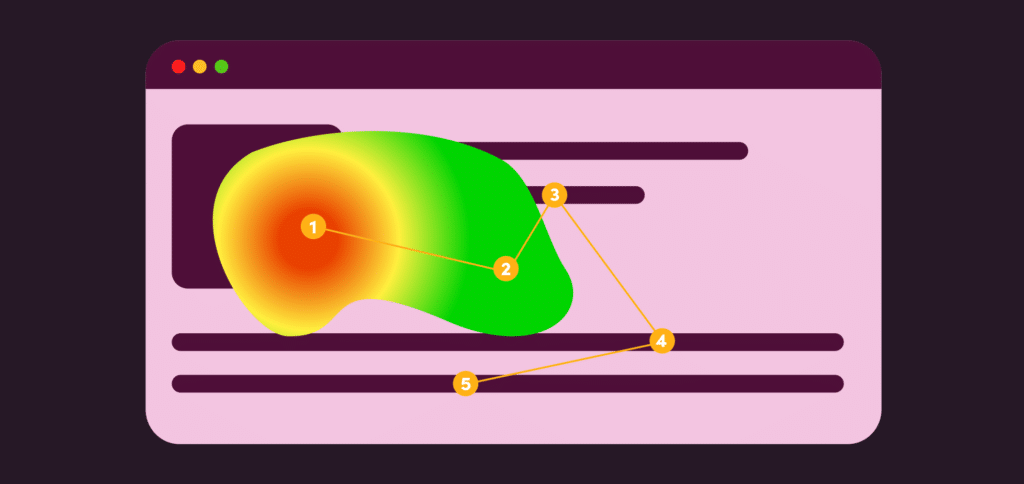User experience (UX) designers create the optimal journey for customers when interacting with a product, service, or website. Some UX designers are increasingly relying on artificial intelligence (AI) to automate the necessary but repetitive tasks so they can focus their time, energy, and effort on elevating their output.
To get a hands-on understanding of how AI assists UX specialists, we sat down with Jake Zastrow, associate UX designer at (human)x, to talk eye-tracking programs, up-and-coming software, and the future of AI for his team.
This blog is the second in a three-part series called “The Human + The Tool” on the real human applications of AI with subject matter experts at (human)x in search engine optimization, UX, and market research.
*Author’s note: This interview was edited and condensed for clarity.
Describe the relationship between AI and UX in your work at (human)x.
JZ: The rise of AI in our work is going to lead us to spend less time on repetitive tasks and more time thinking about design problems and doing truer UX work.
We’ve been using AI in our work at (human)x for half a year or so. We leverage it using tools like Neurons Predict to self-validate work before it goes out into the world and then we can go through our usual agile iteration processes. It gives us a stronger starting point where we can go into it with some idea of validation before it goes out into the world, and then we do the real validation.
What ways are you implementing AI in your work for clients?
JZ: We use Neurons Predict, which is essentially an AI predictive eye tracking tool that gives us tangible, quantitative metrics that we can put in front of clients. It measures things like focus, cognitive demand, clarity, and engagement. It also allows us to compare scores for specific website designs based on different industry benchmarks.
Our team uses Chat GPT when we are doing spec work or we’re moving forward with a website project and we don’t have finalized copy. As opposed to putting in Lorem Ipsum placeholder copy, a lot of times I’ll prompt Chat GPT to create content close to what the actual copy will be. So, when the project goes in front of a client, they’re not just distracted by the fact that it’s all placeholder copy and they can get an idea of what content is going to be there.
We haven’t implemented things like Midjourney too much into our workflow yet. With how much the program is improving, though, I could see that being good, quick asset prototyping software for us.
Describe a project you’ve worked on where AI was an important tool for you.
JZ: AI comes in quite a bit in our digital experience programs when we’re doing ongoing reporting. We’re getting to do that iterative, agile design to continually make optimizations and then go back to check our work with analytics and rerun eye tracking tests.
 Our team is also implementing AI on new web projects to pre-validate these things before they even go in front of the client. Atlas Van Lines has been one of our flagship clients we’ve been using AI with. We use Neurons Predict for Atlas, while putting forward optimization recommendations for their “Get a Quote” form, the main conversion of their site. We’ve run quite a few Neurons Predict tests across their site. We’ll run the quote form and compare side by side the clarity and focus scores for old and new designs, to increase focus and decrease cognitive demand.
Our team is also implementing AI on new web projects to pre-validate these things before they even go in front of the client. Atlas Van Lines has been one of our flagship clients we’ve been using AI with. We use Neurons Predict for Atlas, while putting forward optimization recommendations for their “Get a Quote” form, the main conversion of their site. We’ve run quite a few Neurons Predict tests across their site. We’ll run the quote form and compare side by side the clarity and focus scores for old and new designs, to increase focus and decrease cognitive demand.
I see us using the Neurons Predict program anytime that we’re going to recommend optimizations to any client that will express itself in a user interface type solution.
When you approach these projects, how do you communicate to clients the benefits of AI?
JZ: I haven’t really had to convince any clients of the benefits. We’re building AI into our normal workflow to give more informed work to the client, and clients have been eager to try it out.
In the case someone needs education, I have quite a few pointers in my back pocket about the benefits of Neurons Predict because of how accurate their eye tracking is. They’ve been validated by Ivy League school research groups many times and they’re at about 95% accuracy with their eye tracking model.
Most of our clients understand the benefits of Chat GPT. It’s a very good language model. There are good applications for using it in UX. Instead of having to write everything out on notecards and do traditional UX card sorting, I can go into Chat GPT with a list of different topics or navigation items and prompt it to categorize those things. It takes a little bit of that monotony out of UX work.
We’ve talked about the benefits and opportunities you’ve found while using AI with your work. Have you hit any roadblocks or found any difficulties?
JZ: Sometimes, if you were to ask Chat GPT for a specific article or a specific paper it may just give you fake article names and fake authors. There are certain things like that, that get in the way. You have to be very specific about the prompts that you’re putting in and understand the limitations of it to make sure that you’re leveraging it correctly and not pulling in nonsense from a language model.
As for Neurons Predict, to compare pages one to one it needs to be exact pixel to pixel so you can’t accurately compare one design to another, unless the image you’re uploading is exact to the pixel. It’s a problem, especially when you’re comparing old designs to new designs.
Are there any programs you’re not using right now, but you have an eye on and think you may want to use in the future?
JZ: There are some programs that could give us placeholder copy that would be better than ChatGPT, like Copy.ai or Articulo. Those programs would be more helpful for us in the wireframe iteration processes when we don’t have finalized copy to replace that Lorem Ipsum copy.
What do you think the future of AI and UX looks like for (human)x? Do you think it’s a fad or do you think it’s going to stick around?
JZ: I definitely think AI is going to stick around. We’re going to be using it to cut down on pixel movement and things like that. It’s not going to replace UX thinking and agile design flow. It will make it easier for us to get from the start to first 90% of a project, which is repetitive, and then we can really spend the time perfecting and elevating the last 10% before the design is done to pressure check everything and just make sure that we’re putting the best product we can forward.
UX specialists are still figuring out exactly how we implement this stuff in our workflow, and it’s an ongoing process. The more of these new software and programs come out, the more we’ll try them out and keep adding things to the toolbox.
AI + UX with (human)x
Jake Zastrow’s experience with AI uncovers what an effective tool it can be for UX designers. Here’s what we learned:
- UX designers are finding new ways to implement AI in their work as the field grows.
- AI can be used to automate repetitive tasks that build the foundation of a project, allowing UX designers to spend their time and energy elevating a project with their human touch.
- Sometimes, AI is wrong or misguided. It takes someone with expertise to make these programs reach their potential.
- When applied effectively, AI has the potential to be a mainstay in UX.
AI offers new opportunities for innovation not just in UX, but in search engine optimization (SEO) and market research. The first installment of The Human & The Tool covered AI and SEO with (human)x Senior SEO Analyst Russ Allen. Our final blog in this three-part series will discuss AI and market research with our market research specialists Dr. Timothy Sauer and Rachael Roland.
If you want to learn more about using AI to develop your brand’s UX production, (human)x can help. We blend cutting-edge technology with experienced, creative experts in the field. Check out our website to learn more about our AI and UX capabilities!

